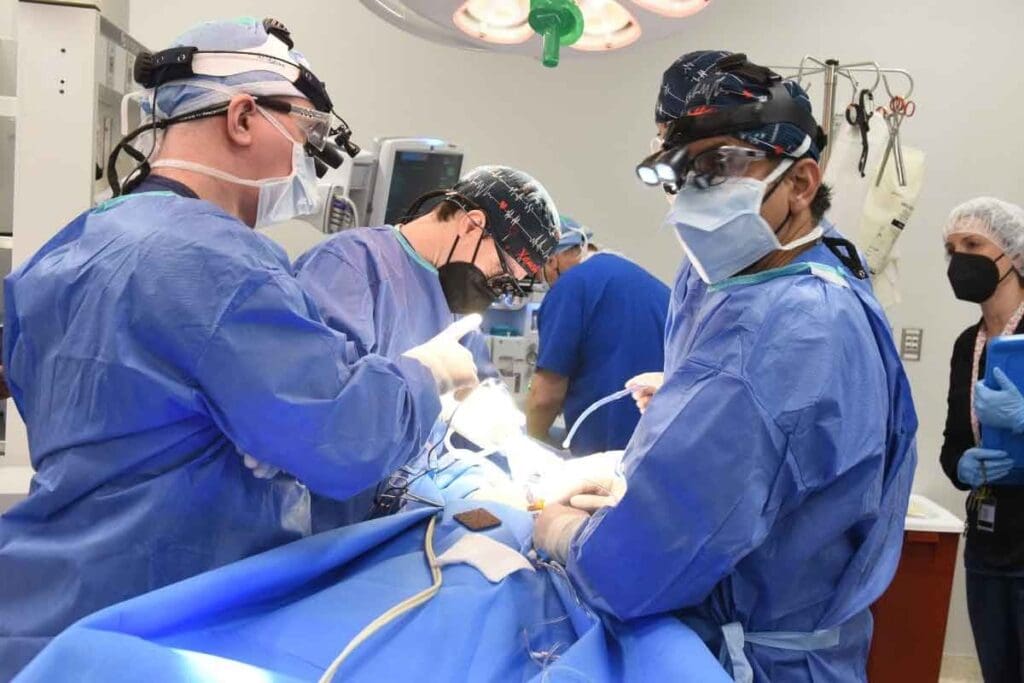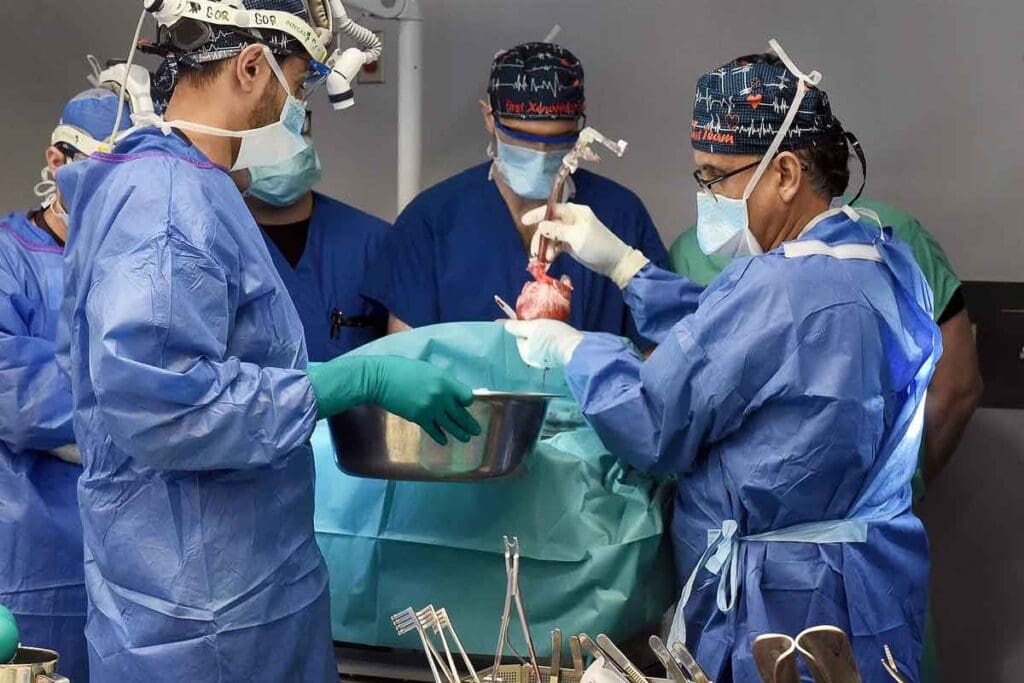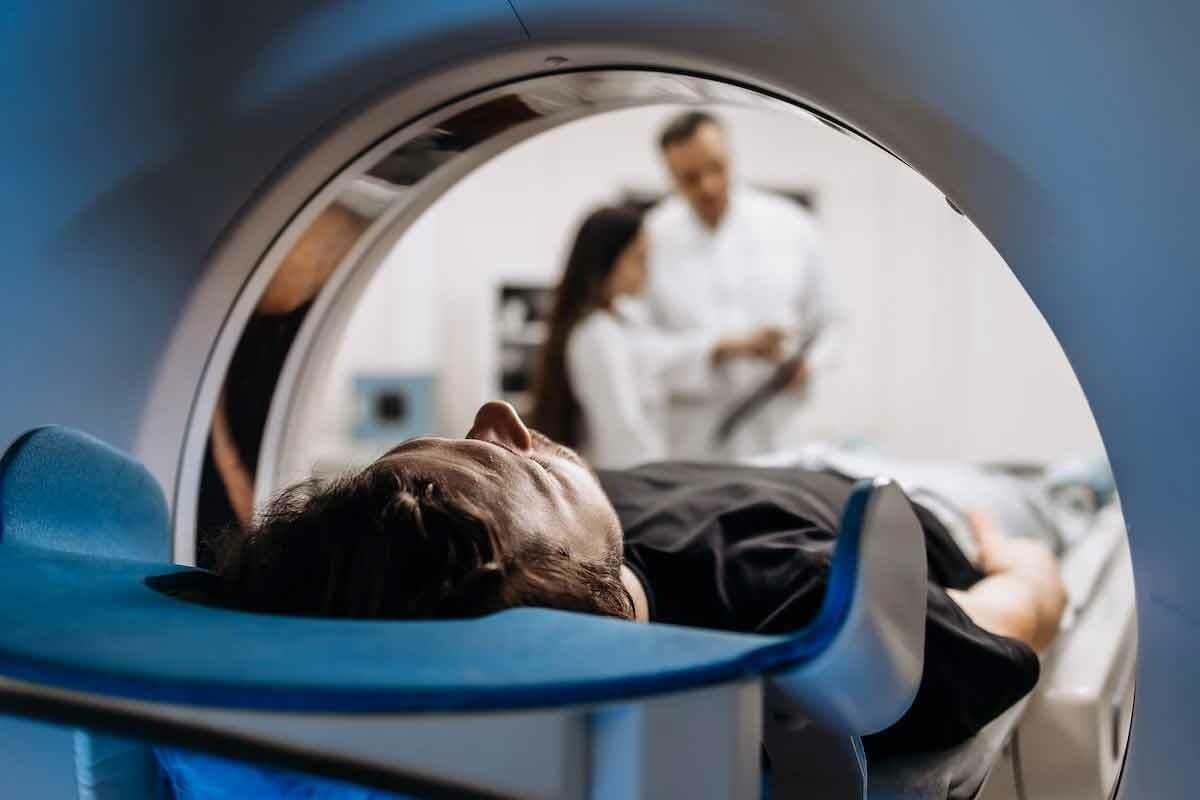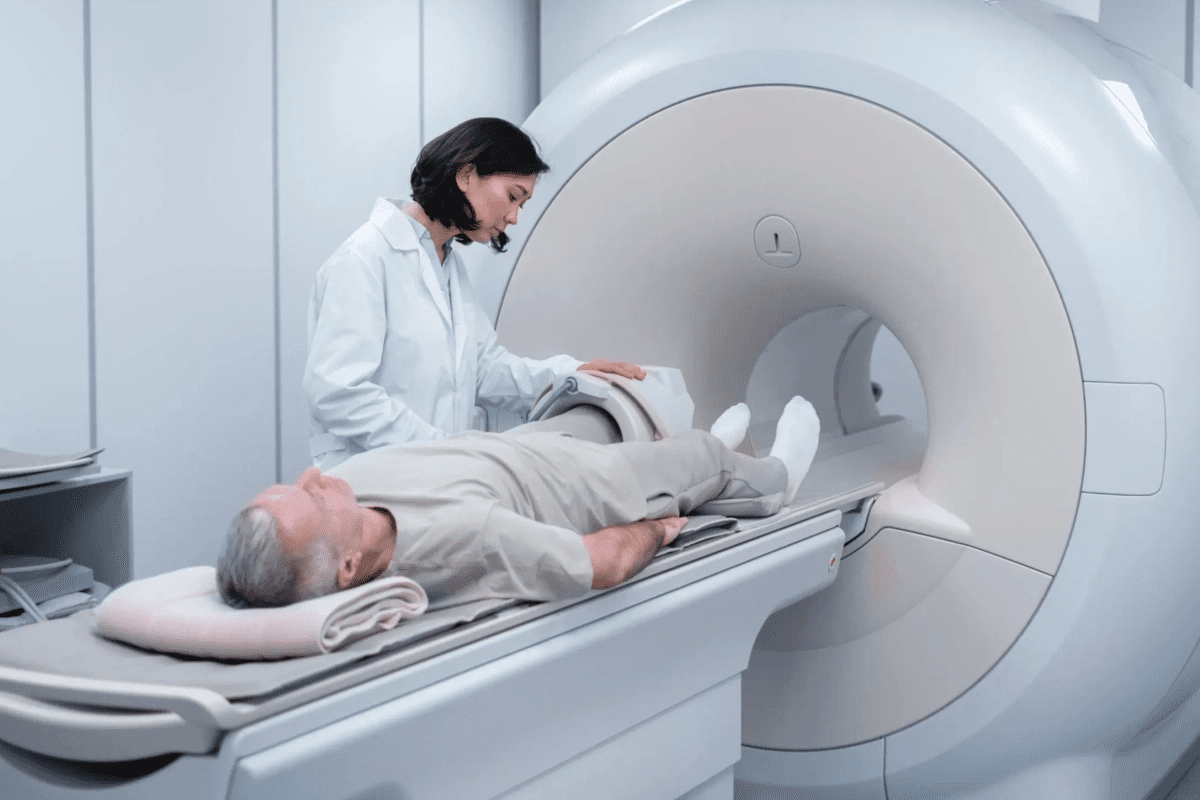Last Updated on November 26, 2025 by Bilal Hasdemir

Blocked artery surgery for the heart is a lifesaving procedure. It’s often done through angioplasty and stent placement. This helps restore blood flow to the heart muscle.
Angioplasty uses a tiny balloon to widen the artery. This improves blood circulation. It’s a key treatment for coronary artery disease.
Knowing the steps of stent placement helps patients prepare. It’s a potentially life-saving treatment.
Key Takeaways
- Angioplasty and stent placement are used to treat coronary artery disease.
- The procedure involves widening the artery using a tiny balloon.
- Stent placement helps keep the artery open, improving blood flow.
- Understanding the process can help patients prepare for treatment.
- Minimally invasive, reducing recovery time.
Understanding Coronary Artery Disease and Blockages

Coronary artery disease happens when plaque builds up in the coronary arteries. This can lead to blockages that harm heart health. The buildup is caused by fatty deposits, cholesterol, and other substances on the artery walls, known as atherosclerosis.
How Plaque Builds Up in Coronary Arteries
Plaque buildup in coronary arteries starts early in life. High cholesterol, smoking, hypertension, and diabetes can make it worse. As plaque grows, it narrows the artery, reducing blood flow to the heart.
| Risk Factor | Description | Impact on Coronary Artery Disease |
| High Cholesterol | Elevated levels of LDL cholesterol | Increases plaque formation |
| Smoking | Use of tobacco products | Damages artery walls, accelerates plaque buildup |
| Hypertension | High blood pressure | Increases strain on arteries, promotes plaque buildup |
Symptoms of Coronary Artery Blockage
Symptoms of coronary artery blockage include chest pain (angina), shortness of breath, and fatigue. These happen because the heart muscle doesn’t get enough oxygen-rich blood. A complete blockage can cause a heart attack.
When Surgical Intervention Becomes Necessary
Surgical intervention, like angioplasty and stent placement, is needed for severe blockages. This procedure uses a balloon-tipped catheter to widen the artery and a stent to keep it open.
It’s important to understand when surgery is needed for coronary artery disease. Recognizing symptoms and risk factors helps patients work with their doctors. This may include angioplasty and stenting to improve blood flow to the heart.
Blocked Artery Surgery for the Heart: Overview and Options

Angioplasty and stent placement have changed how we treat blocked heart arteries. These methods are key in fighting coronary artery disease, a big problem worldwide.
Every year, over 2 million people get stents in their coronary arteries. This has cut down chest pain and heart attack risks for those with big blockages. The mix of angioplasty and stenting has greatly improved patient results.
Defining Angioplasty and Stent Placement
Angioplasty uses a balloon to open blocked arteries. The balloon is inflated to push against the artery wall, improving blood flow. A metal stent is then placed to stop the artery from narrowing again.
A stent is like a small, mesh tube put into the artery to keep it open. It’s usually put in during an angioplasty.
“The use of stents in coronary arteries has transformed the management of coronary artery disease, giving patients a less invasive way to deal with a serious condition.”
How Stents Work to Keep Arteries Open
Stents act as a support for the artery after angioplasty. They keep the artery from closing or getting blocked again.
The stent is placed at the blockage, expanding to support the artery walls. Over time, it becomes part of the artery wall, providing a lasting fix.
Success Rates and Statistical Outcomes
Research shows angioplasty with stent placement works well for blocked arteries. Most patients see better symptoms and life quality.
| Procedure | Success Rate | Complication Rate |
| Angioplasty with Stent | 95% | 5% |
| Angioplasty without Stent | 80% | 20% |
The numbers show angioplasty with stenting is a top treatment for heart artery disease. It greatly lowers the chance of future heart issues.
Types of Stents Used in Modern Cardiology
Modern cardiology uses different stent technologies to fix blocked heart arteries. Each stent has its own benefits and features. Stents are small, metal mesh tubes that keep arteries open after angioplasty.
Bare Metal Stents: Structure and Function
Bare metal stents are made from stainless steel or other metals. They provide support to the artery wall. They are often used in angioplasty to keep the artery open.
- They are less expensive compared to drug-eluting stents.
- They have a higher risk of restenosis (re-narrowing of the artery).
Drug-Eluting Stents: Preventing Restenosis
Drug-eluting stents are coated with medications that prevent new tissue growth. This reduces the risk of restenosis. They are more effective than bare metal stents in preventing artery narrowing.
Key benefits include:
- Reduced risk of restenosis.
- Lower likelihood of needing more procedures.
Bioabsorbable Stents: New Developments
Bioabsorbable stents are made from materials that the body absorbs over time. They aim to reduce long-term complications of metal stents. This is a new technology in cardiology.
The advantages of bioabsorbable stents include:
- Potential reduction in long-term complications.
- Restoration of normal artery function.
Medical Evaluation and Candidacy Assessment
A detailed medical evaluation is key to seeing if a patient is right for stent placement. This includes many tests and talks with a cardiologist. They check how bad the heart disease is.
Diagnostic Tests to Confirm Blockages
Several tests are used to find and measure blockages. These include:
- Stress Test: Checks how the heart works when stressed, often with a treadmill or medicine.
- Coronary Angiogram: A dye is put into the heart’s arteries through a catheter. X-rays show the blockages.
- Electrocardiogram (ECG): Records the heart’s electrical activity to spot problems or past damage.
- Cardiac Catheterization: A catheter is put in an artery to measure pressure and take blood samples.
Consultation with Your Cardiologist
After tests, talking to a cardiologist is vital. They will discuss the test results and treatment options. The cardiologist will:
- Go over the test results and explain the blockage severity.
- Talk about the risks and benefits of angioplasty and stenting.
- Discuss other treatments like lifestyle changes, medicine, or CABG.
Alternative Treatments When Stenting Isn’t Appropriate
Stenting might not be the best choice for everyone. Based on the blockage and the patient’s health, other treatments are suggested. These can be:
- Medications: To help manage symptoms and slow the disease.
- Lifestyle Changes: Changes in diet, more exercise, quitting smoking, and reducing stress.
- Coronary Artery Bypass Grafting (CABG): A surgery to bypass blocked arteries with grafts.
The choice to do angioplasty and stenting is made after weighing these options. It’s a decision made with a cardiologist’s advice.
Preparing for Your Heart Stent Procedure
Getting ready for a heart stent procedure is important. Your healthcare team will help you with each step. This ensures a smooth and successful experience.
Medication Adjustments Before Surgery
You might need to stop taking blood thinners before surgery. It’s vital to follow your doctor’s advice on medications to avoid bleeding risks.
Some medicines might need to be changed or stopped. Make sure your cardiologist knows about all your current medications. This includes:
- Anticoagulants (blood thinners)
- Aspirin
- Other prescription and over-the-counter medicines
Fasting and Other Pre-Procedure Requirements
Fasting is usually needed before the procedure. Your healthcare provider will tell you how long. This time can vary based on the procedure and your health.
Other things you might need to do include:
- Arriving at the hospital on time
- Having someone with you at the hospital
- Removing jewelry or items that could get in the way
What to Bring to the Hospital
Bring things to make your stay comfortable. This includes:
- Comfortable clothes
- Insurance cards and ID
- A list of your medications and how much to take
- Personal items to help you relax
Mental Preparation and Setting Expectations
Mental preparation is key. Knowing what to expect can lower your anxiety. Talk to your cardiologist about any worries or questions.
“The more you know about what’s happening, the less intimidating it becomes.” – A cardiologist’s advice to patients preparing for a heart stent procedure.
Having a support system is also important. This could be family, friends, or a support group. They can help you during recovery.
Step-by-Step: The Angioplasty Procedure
The angioplasty procedure is a minimally invasive treatment. It widens narrowed or obstructed coronary arteries. This is key for patients with coronary artery disease, as it restores blood flow to the heart.
Arrival and Initial Preparation
“The angioplasty procedure is a big step forward in treating coronary artery disease,” says a leading cardiologist. “It shows how medical technology has improved to offer less invasive and effective treatments.”
Catheter Insertion and Navigation
A thin tube, or catheter, is then guided through the artery to the blocked area. This is done under imaging guidance for precise placement. The catheter is carefully moved through the arterial system until it reaches the coronary artery blockage.
Locating the Blockage via Angiogram
With the catheter in place, a contrast dye is injected to see the blockage on an angiogram. This imaging lets the cardiologist check the blockage’s severity and plan the next steps.
Balloon Inflation to Widen the Artery
A balloon on the catheter is then inflated to widen the artery. This compresses the plaque and improves blood flow. This step is key for the stent for heart procedure, as it prepares the artery for the stent. After the balloon is inflated, the artery is widened, and the stent is left to keep the artery open.
The whole step-by-step angioplasty process is designed to be efficient and safe. The medical team closely watches the patient’s condition throughout.
The Stent Placement Process
The stent placement process is key in angioplasty. It makes sure the artery stays open. This process has several important steps for the stent’s successful deployment.
Positioning the Stent at the Blockage Site
The stent is mounted on a balloon catheter. It is then guided to the blockage in the artery. Precise positioning is vital to cover the entire blockage. The stent expands when the balloon is inflated, embedding into the arterial walls to keep the artery open.
Deploying the Stent in the Artery
When the stent is in the right spot, the balloon is inflated. This expands the stent. It embeds into the plaque and the arterial wall, widening the artery and improving blood flow. The stent stays in place, providing permanent support to the artery.
Confirming Proper Placement
An angiogram is done after deploying the stent. It checks if the stent is in the right place and if blood flow has improved. This step is vital to make sure the stent works as it should and there are no immediate problems.
Removing the Catheter System
After the stent is deployed and its position confirmed, the balloon catheter is deflated and carefully removed. The stent stays in place, keeping the artery open and improving blood flow to the heart.
| Step | Description | Key Considerations |
| 1. Positioning | Guiding the stent to the blockage site | Precise positioning is vital |
| 2. Deployment | Inflating the balloon to expand the stent | Ensuring the stent embeds into the arterial wall |
| 3. Confirmation | Verifying stent placement via angiogram | Confirming proper blood flow and stent position |
| 4. Removal | Deflating and removing the catheter system | Careful removal to avoid complications |
What Patients Experience During the Procedure
Having a heart stent procedure can be scary, but knowing what to expect can help. The procedure is done under local anesthesia. This keeps you comfortable the whole time.
Level of Consciousness and Sedation
You’ll get medicine to relax during the procedure. You’ll be awake but very relaxed, in a state of conscious sedation. This means you can talk to your team if needed.
Sensations and Discomfort to Expect
You might feel some sensations during the procedure, but they’re not usually painful. You might feel pressure or discomfort when the catheter is put in or when the balloon is used. But this feeling is short-lived and can be managed.
The medical team will do their best to keep you comfortable. They can adjust the sedation or the procedure as needed. It’s important to tell them if you feel any pain or discomfort.
Communication with the Medical Team
Even though you’ll be sedated, you can talk to your medical team. They will check in with you to make sure you’re okay and to answer any questions. Let them know if you feel any pain or discomfort so they can help.
Knowing what to expect during the heart stent procedure can help you feel less anxious. It makes the whole experience smoother.
Immediate Post-Procedure Recovery
After angioplasty and stent placement, the recovery phase is key. It involves close monitoring to ensure a smooth recovery.
Monitoring in the Recovery Room
Patients go to the recovery room after the procedure. Here, they are watched for hours. Medical staff check vital signs like heart rate and blood pressure.
Managing the Insertion Site
The site where the procedure was done is watched for bleeding. Patients are told to keep it clean and dry. A compression device may be used to stop bleeding.
Initial Movement Restrictions
Moving too much can cause bleeding. So, patients are told to stay quiet and not bend for a few hours. They can usually walk around in 6 to 8 hours, depending on their health and the doctor’s advice.
Pain Management and Comfort Measures
Managing pain is important after the procedure. Patients might feel some pain, which can be treated with medicine. Comfort measures like adjusting the bed or creating a calm space also help.
A patient shared, “The care I got during recovery was amazing. The team was always there for me, making a big difference in my recovery.”
Recovery Timeline and Returning to Normal Activities
Recovering from a heart stent procedure takes time, and following a specific timeline is important. It involves several stages, from leaving the hospital to slowly getting back to normal life.
Hospital Discharge Process
Most patients leave the hospital a day or two after the procedure. Before going home, your healthcare team will give you instructions. This includes how to care for the insertion site, your medication, and when to come back for follow-ups.
First Week: Essential Restrictions
In the first week, avoid heavy lifting, bending, or hard work. It’s important to rest and let your body heal. Light walking is okay to help blood flow and prevent problems.
Weeks 2-4: Gradual Activity Resumption
Starting from the second to fourth week, you can start to do more. This might include walking faster, doing light exercises, or going back to work. This depends on how hard your job is and what your doctor says.
Long-Term Recovery Milestones
By the end of the first month, most people have recovered well and can do normal things again. But keep following your doctor’s advice and go to all your follow-up appointments. This helps keep an eye on the stent in the heart and your heart health. Knowing the recovery timeline and sticking to it is important for a successful return to normal activities.
Potential Risks and Complications
Stent placement is usually safe, but there are risks and complications. Knowing these is key to making a good choice.
Common Minor Complications
Minor issues might include bleeding or bruising where the catheter was inserted. You might also feel temporary discomfort or have an allergic reaction to the dye. Most of these problems are manageable and get better on their own.
Serious Complications Requiring Immediate Attention
Though rare, serious problems can happen. These include bleeding, damage to the blood vessel, or an allergic reaction to the drug in drug-eluting stents. If you have severe chest pain, trouble breathing, or heavy bleeding, get immediate medical attention.
“The risk of serious complications with stent placement is low, but patients need to be aware of the signs to watch for post-procedure.” –
A leading cardiologist
Signs of Stent Failure or Restenosis
Stent failure or restenosis can happen months or years later. Look out for recurring chest pain or shortness of breath. It’s important to keep up with regular check-ups with a cardiologist to watch the stent’s health.
Statistical Likelihood of Complications
Research shows the risk of serious problems with stent placement is low, between 1-3%. But the risk can change based on your health and the procedure details.
Knowing about the risks and complications of stent placement helps patients make better choices. It’s important to talk about any worries with a healthcare provider.
Conclusion: Living Successfully with a Heart Stent
Having blocked artery surgery can change your life. With the right care, people with heart stents can live active lives. By sticking to a healthy lifestyle and taking medication, you can lower the risk of problems.
To live well with a heart stent, focus on a healthy lifestyle. Eat well, exercise regularly, and manage stress. Also, don’t forget to see your cardiologist for check-ups to keep an eye on your stent.
Knowing about your heart stent and its care is key. This knowledge helps you manage your heart health better. With the right steps, you can avoid future heart issues and stay healthy, living well with a heart stent.
FAQ
What is a heart stent operation?
A heart stent operation, also known as angioplasty and stent placement, is a minimally invasive procedure. It opens blocked or narrowed coronary arteries. A small, mesh-like tube called a stent is inserted into the artery to keep it open.
What is the purpose of stent placement in the heart?
The main goal of stent placement is to restore blood flow to the heart muscle. This keeps the coronary artery open. It helps relieve symptoms like chest pain and shortness of breath, and lowers the risk of a heart attack.
How is a stent placed in the heart?
A stent is placed in the heart through angioplasty. A catheter is inserted into an artery in the leg or arm. It is guided to the blocked coronary artery. A balloon on the catheter is inflated to widen the artery, and the stent is deployed to keep it open.
What are the different types of stents used in cardiology?
There are several types of stents used in cardiology. Bare metal stents are made of metal mesh. Drug-eluting stents release medication to prevent restenosis. Bioabsorbable stents are made of a material that is absorbed by the body over time.
What is the success rate of angioplasty and stent placement?
Angioplasty and stent placement are highly successful, with a success rate of over 90%. The procedure effectively relieves symptoms and improves the quality of life for most patients.
What are the possible risks and complications of stent placement?
Stent placement may have minor complications like bruising and bleeding. More serious complications include stent failure, restenosis, and heart attack. But these are rare.
How long does it take to recover from a heart stent procedure?
The recovery time for a heart stent procedure varies. Most patients are discharged from the hospital within a day or two. It may take several weeks to fully recover and resume normal activities.
What are the signs of stent failure or restenosis?
Signs of stent failure or restenosis include recurring symptoms like chest pain, shortness of breath, and fatigue. If you experience these symptoms, contact your doctor immediately.
Can I undergo angioplasty and stent placement if I have other health conditions?
Your doctor will assess your overall health to determine if you are a candidate for angioplasty and stent placement. Certain health conditions, like kidney disease or bleeding disorders, may affect your eligibility.
How is a stent different from angioplasty?
Angioplasty is the procedure to widen a blocked or narrowed artery. A stent is a device to keep the artery open. Angioplasty is often performed with stent placement to ensure the artery remains open.
What is the role of medication after stent placement?
After stent placement, you will be prescribed medication. This is to prevent blood clots from forming on the stent and to manage other conditions like high blood pressure and high cholesterol.
References
- Al-Lamee, R. K., Nowbar, A. N., & Francis, D. P. (2018). Percutaneous coronary intervention for stable coronary artery disease. The New England Journal of Medicine, 379(2), 139-146 https://pubmed.ncbi.nlm.nih.gov/30242142/






